The glamorous era of the 1930s brought us some of the most elegant and sophisticated hairstyles that continue to inspire modern fashion.
When you think of Old Hollywood charm, finger waves cascading into intricate updos, and the timeless beauty of stars like Jean Harlow and Greta Garbo, you’re imagining the golden age of hairstyling artistry.
This comprehensive guide to 33 Vintage 1930s Updo Hairstyles for Special Occasions will transport you back to an era where every curl was deliberately placed and every pin served a purpose.
Whether you’re preparing for a wedding, gala, themed party, or simply want to channel vintage elegance for your next special event, these classic styles offer endless inspiration.
From the iconic Marcel waves to the sophisticated chignon variations, each hairstyle in this collection represents the pinnacle of 1930s beauty standards while remaining surprisingly wearable for today’s occasions.
You’ll discover detailed descriptions of finger wave techniques, pin curl formations, and the architectural updos that defined a decade of unparalleled glamour, along with practical tips for recreating these stunning looks with modern tools and products.
Contents
- 1 1. Classic Finger Wave Updo
- 2 2. Marcel Wave Chignon
- 3 3. Pin Curl Crown with Low Bun
- 4 4. Side-Swept Wave Roll
- 5 5. Victory Roll Variation
- 6 6. Braided Crown Updo
- 7 7. Rolled Pompadour Style
- 8 8. Cluster Curl Arrangement
- 9 9. Smooth Chignon with Side Part
- 10 10. Twisted Rope Updo
- 11 11. Deep Wave Side Sweep
- 12 12. Figure Eight Bun
- 13 13. Romantic Low Chignon
- 14 14. Sculptured Wave Crown
- 15 15. Vintage Roll and Tuck
- 16 16. Asymmetrical Wave Arrangement
- 17 17. Pearl-Adorned Chignon
- 18 18. Horizontal Roll Style
- 19 19. Finger Wave Bob Updo
- 20 20. Wrapped Chignon Base
- 21 21. Tiered Wave Formation
- 22 22. Grecian-Inspired Updo
- 23 23. Swept Back Wave Style
- 24 24. Faux Bob Updo
- 25 25. Ornate Side Bun
- 26 26. Criss-Cross Pin Pattern
- 27 27. Double Chignon Style
- 28 28. Waterfall Wave Cascade
- 29 29. Coronet Braid Updo
- 30 30. Nested Pin Curl Cluster
- 31 31. Sleek Top with Textured Nape
- 32 32. Spiral Roll Formation
- 33 33. Art Deco Geometric Updo
- 34 Conclusion
1. Classic Finger Wave Updo
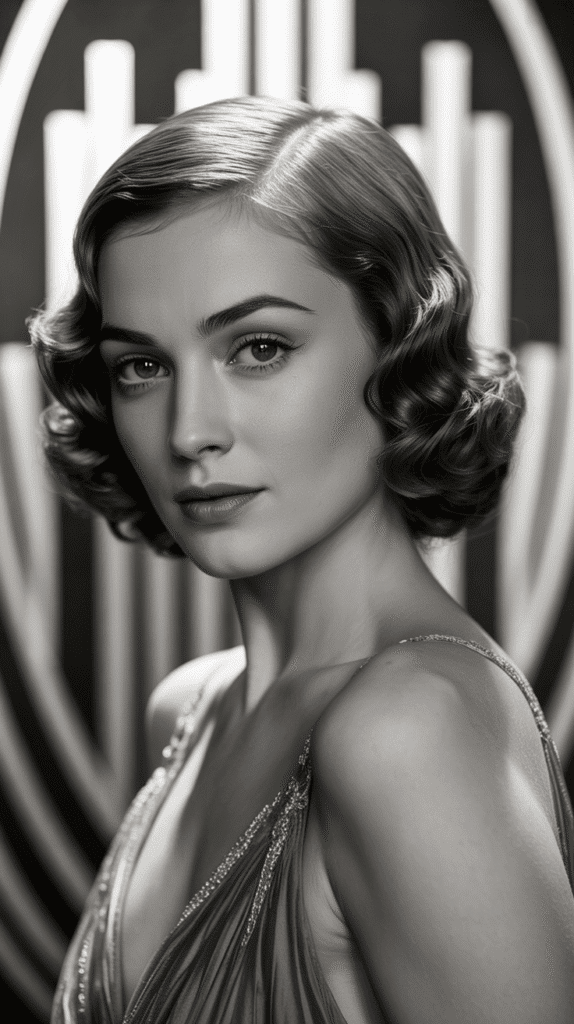
The Classic Finger Wave Updo represents the quintessential 1930s hairstyle that epitomized Hollywood glamour and sophisticated femininity.
This style combines the signature S-shaped waves close to the scalp with an elegant updo at the crown or nape, creating a look that’s both structured and romantic.
- The finger wave technique originated in the 1920s but reached its peak popularity and refinement during the 1930s when it became the hallmark of elegant evening wear
- This hairstyle works exceptionally well for formal events like weddings, galas, and vintage-themed celebrations where authentic period styling is desired
- The waves are created by pinching the hair between fingers while applying setting lotion, forming deep ridges that catch light beautifully
- Modern stylists often use a combination of traditional setting techniques and contemporary tools like flat irons to achieve the characteristic wave pattern
- The updo portion can be customized with various arrangements including low buns, rolled sections, or pinned clusters depending on hair length and personal preference
- For longevity, the style requires strong-hold products and careful setting, often benefiting from overnight wave formation before the final updo assembly
- This look pairs beautifully with Art Deco jewelry, particularly hair combs with geometric designs and drop earrings that complement the face-framing waves
2. Marcel Wave Chignon
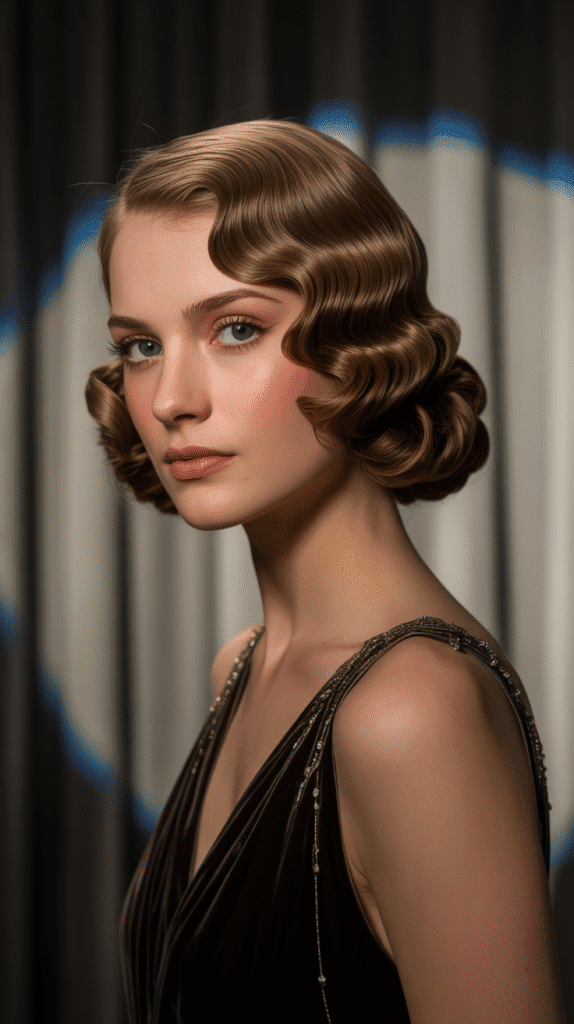
The Marcel Wave Chignon combines the luxurious depth of Marcel waves with the classic refinement of a chignon base, creating a hairstyle that exudes timeless sophistication.
Named after Marcel Grateau who invented the curling iron technique, this style became a status symbol among fashionable women of the era.
- Marcel waves differ from finger waves in their creation method, using heated irons to create deeper, more pronounced S-curves that add dramatic dimension
- The chignon base sits typically at the nape of the neck, providing a stable foundation for the elaborate wave work that frames the face
- This hairstyle requires sectioning the hair carefully, with front sections reserved for wave formation while back sections are smoothly gathered into the chignon
- The technique demands precision and practice, as the heated iron must be held at specific angles to achieve the characteristic alternating ridges and troughs
- Professional stylists recommend using thermal protection products generously when recreating this look with modern curling irons or Marcel irons
- The style works best on medium to long hair with some natural body, though extensions can be incorporated for added fullness in the chignon
- Historical context shows this was a favorite among silver screen actresses who needed hairstyles that photographed beautifully under studio lighting
3. Pin Curl Crown with Low Bun
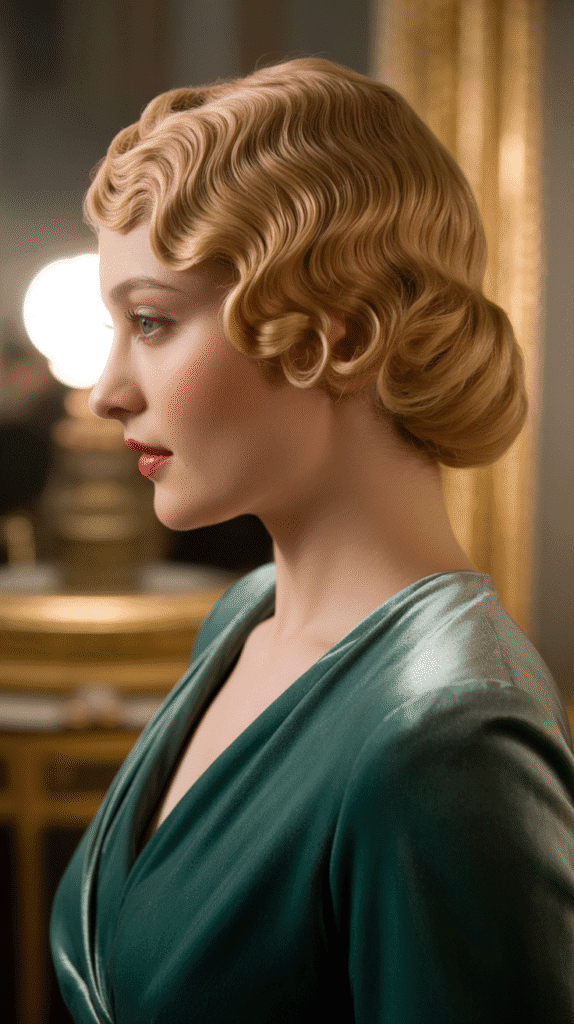
The Pin Curl Crown with Low Bun showcases the intricate artistry of 1930s hairstyling through meticulously arranged pin curls that create texture and volume at the crown.
This style perfectly balances structured elegance with soft, romantic elements.
- Pin curls are formed by wrapping small sections of hair in flat circles against the scalp and securing them with bobby pins or clips until completely dry
- The crown section features strategically placed pin curls that create lift and gentle waves, adding height without appearing overly voluminous
- The low bun serves as an anchor point, keeping the style secure throughout lengthy events while maintaining a graceful neckline
- This hairstyle offers versatility in terms of formality, working equally well for daytime garden parties and evening soirées depending on accessories
- The technique allows for natural hair texture to shine through while still achieving the polished appearance characteristic of the decade
- Setting the pin curls can be done on damp hair with setting lotion, allowing them to dry naturally or with a hooded dryer for faster results
- Once unwound, the pin curls are gently brushed and arranged to create soft, controlled waves that flow seamlessly into the bun
4. Side-Swept Wave Roll
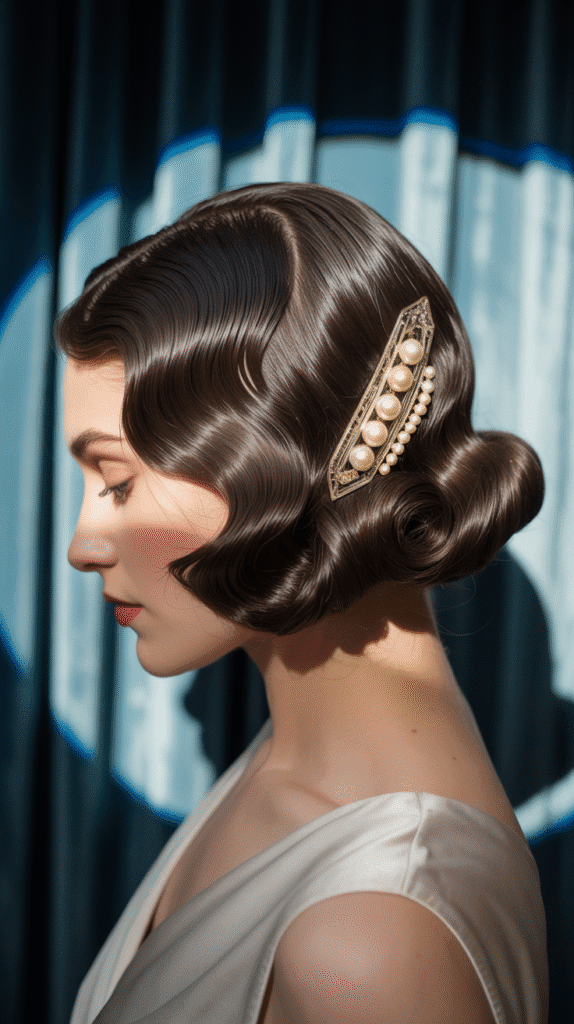
The Side-Swept Wave Roll captures the asymmetrical beauty that defined 1930s styling, where balance was intentionally disrupted to create visual interest and modern flair.
This dramatic style sweeps all hair to one side before rolling it into an elegant vertical arrangement.
- The asymmetrical approach was revolutionary for its time, moving away from centered styles to create a more dynamic and fashion-forward appearance
- All hair is brushed to one side of the head, typically the right, where it’s formed into deep waves before being rolled upward and secured
- The wave formation follows the head’s contour, creating a sculptural effect that appears both architectural and fluid
- This style requires significant pinning and setting to maintain its dramatic swept appearance throughout an event
- Hair accessories like jeweled clips or feather ornaments were often placed at the roll’s base to add glamorous embellishment
- The exposed ear on one side made this style perfect for showcasing statement earrings, which were growing increasingly popular in the era
- Modern recreations often incorporate invisible elastic bands and strategic teasing for added security and volume
5. Victory Roll Variation
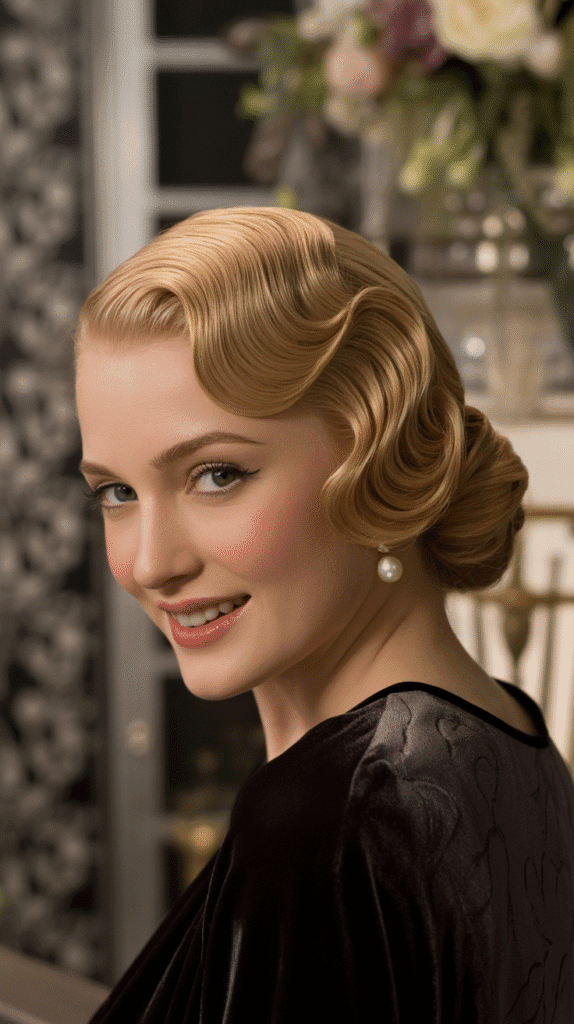
The Victory Roll Variation, though more commonly associated with the 1940s, had its origins in late 1930s styling when rolled elements began appearing in formal updos.
This precursor style features elegant rolls that frame the face while maintaining the decade’s characteristic smoothness.
- The rolls in 1930s versions are typically more subtle and integrated into the overall updo structure rather than standing as prominent separate elements
- Hair is sectioned at the temples and front, with each section rolled backward and pinned to create frame-like structure around the face
- The remaining hair is styled into waves or gathered into a bun, creating a cohesive look that balances the rolled front sections
- This style works exceptionally well for heart-shaped and oval faces, as the rolls add width at the temples and draw attention to the eyes
- The technique requires back-combing at the roots to create sufficient volume for the rolls to maintain their shape throughout wear
- Setting spray and bobby pins are essential for keeping the rolls secure, especially in humid conditions or during dancing
- The style bridges the gap between different vintage decades, making it versatile for various period-themed events
6. Braided Crown Updo
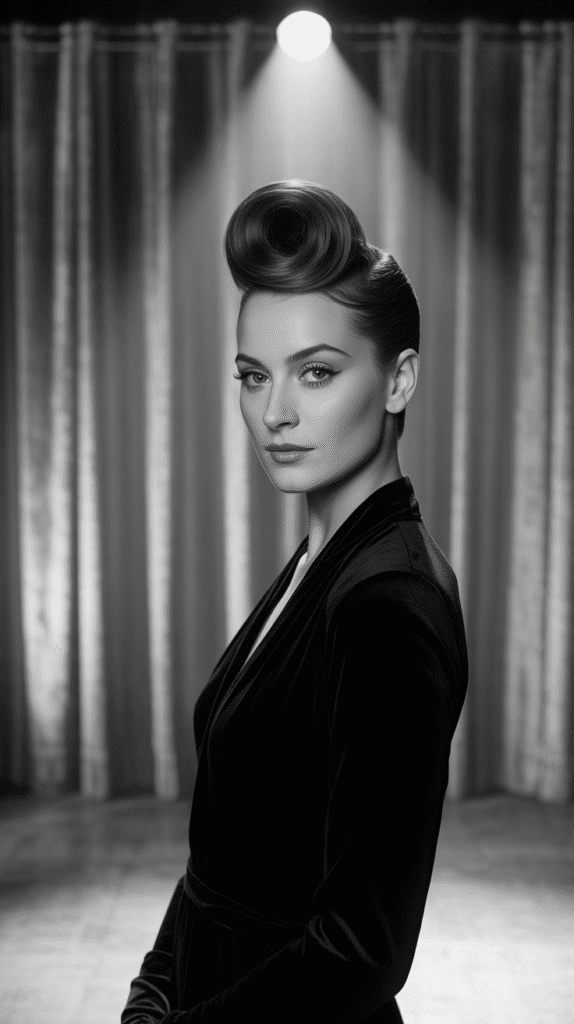
The Braided Crown Updo brings a softer, more romantic interpretation to 1930s styling while maintaining the era’s emphasis on structured elegance.
This hairstyle incorporates braiding techniques that create a crown-like effect around the head.
- The braided crown is formed by creating one or more braids that wrap around the head like a halo, starting from one side and pinning at the opposite side
- This style was particularly popular for daytime occasions and garden parties where a slightly less formal but still polished appearance was desired
- The remaining loose hair is typically waved and arranged into a bun or cluster of curls at the nape or side
- Braiding adds textural interest that contrasts beautifully with the smooth waves characteristic of the period
- The style works well for various hair types, with thicker hair creating more substantial braids and finer hair benefiting from gentle teasing within the braid
- Fresh flowers or ribbon could be woven through the braids for outdoor summer events, adding a touch of natural beauty
- Modern interpretations often incorporate fishtail or Dutch braiding techniques for added dimension and visual complexity
7. Rolled Pompadour Style
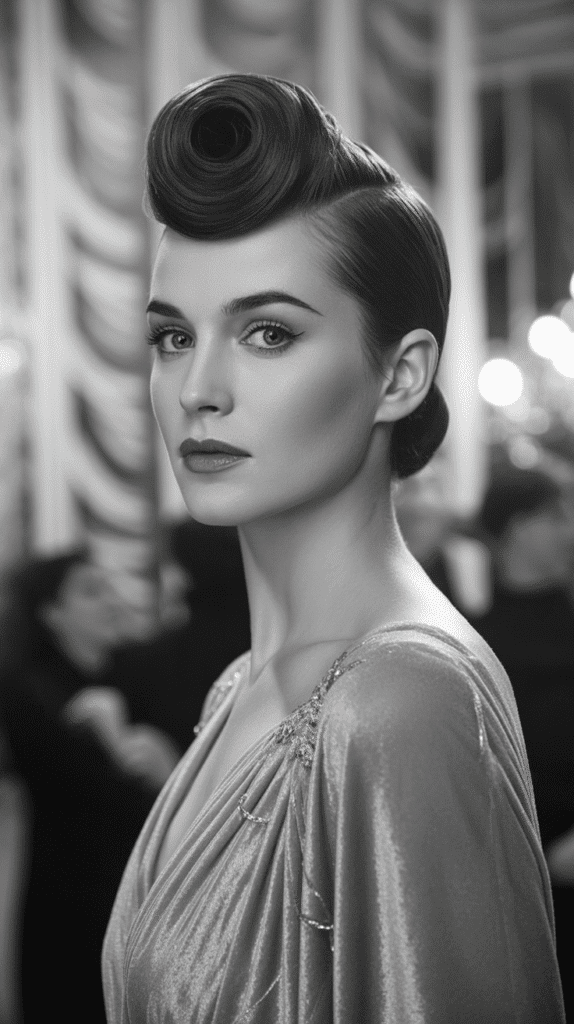
The Rolled Pompadour Style elevates the forehead area with a dramatic rolled section that adds height and grandeur to the overall silhouette.
This bold interpretation of 1930s styling made a strong fashion statement at formal evening events.
- The pompadour section is created by back-combing hair at the front and crown, then smoothing the surface while maintaining volume underneath
- The rolled portion sits prominently at the forehead, sometimes extending several inches high depending on desired drama and face shape
- Back sections are typically sleekly styled into waves or a bun, creating contrast between the voluminous front and controlled back
- This style particularly suited women with longer face shapes, as the horizontal emphasis of the roll created balancing width
- Strong-hold pomade or modern styling creams are essential for achieving the smooth, glossy finish characteristic of authentic 1930s pompadours
- The style requires strategic pinning underneath the roll to create a stable foundation that prevents collapse during wear
- Variations could include adding finger waves to the pompadour section for additional textural interest and period authenticity
8. Cluster Curl Arrangement
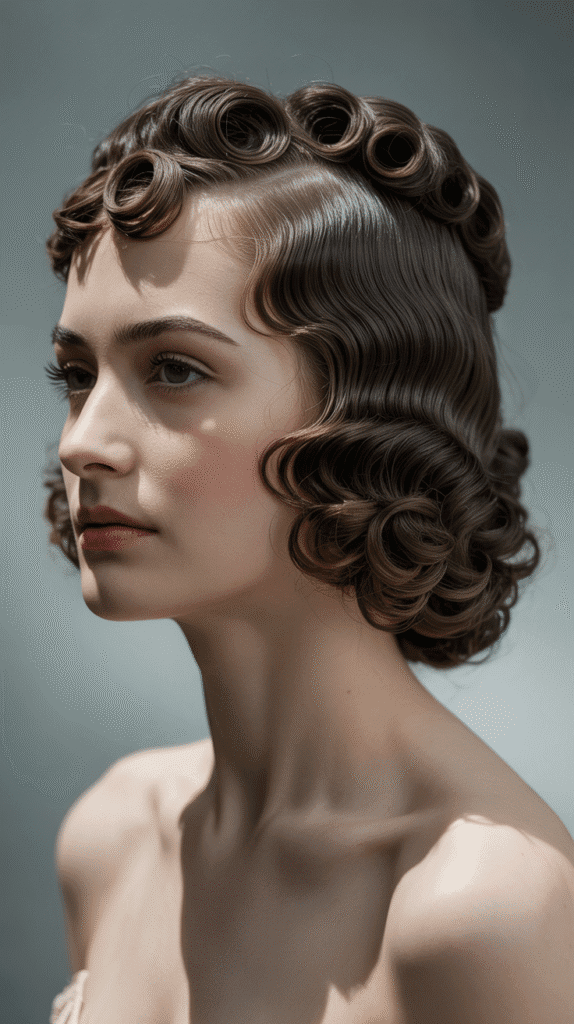
The Cluster Curl Arrangement showcases the deliberate placement of individual curls grouped together to create focal points of texture and movement.
This style emphasizes the craftsmanship involved in 1930s hairstyling where each curl served a decorative purpose.
- Curls are formed using various techniques including pin curls, rag curls, or heated rollers, then arranged in strategic clusters rather than uniformly distributed
- The clusters typically appear at the nape, temples, or crown, with surrounding hair styled smoothly to emphasize the textural contrast
- This asymmetrical approach to curl placement creates visual interest and movement that catches light beautifully from different angles
- The style allows for personalization based on best features, with clusters positioned to frame and flatter individual face shapes
- Each curl within the cluster maintains its individual definition rather than being brushed into waves, preserving the sculptural quality
- Hair accessories like jeweled pins or small combs are often inserted within or near clusters for added embellishment
- The technique requires patience and precision, as each curl must be individually placed and secured to maintain the intended arrangement
9. Smooth Chignon with Side Part
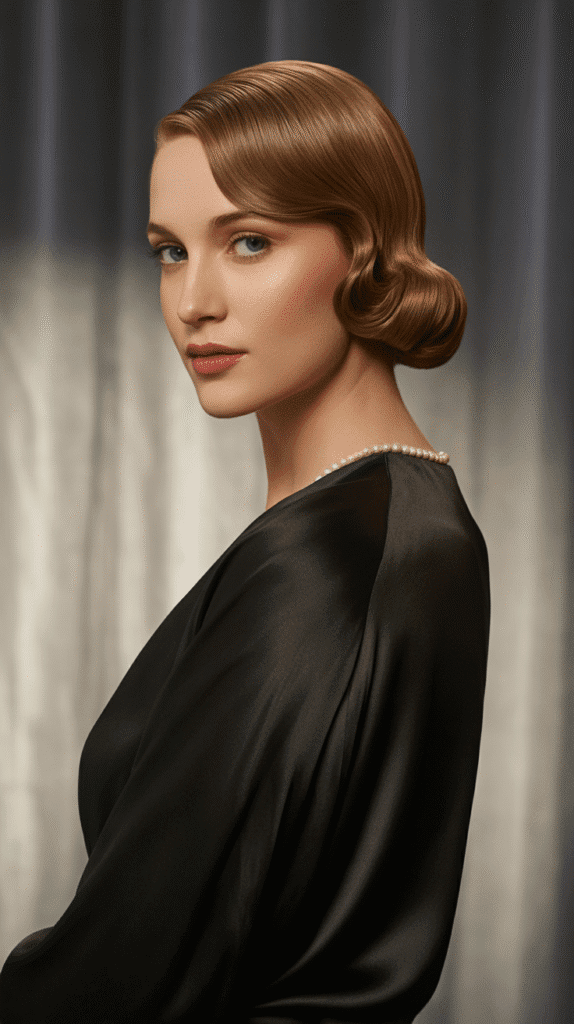
The Smooth Chignon with Side Part represents refined minimalism in 1930s styling, where sleekness and precision took precedence over elaborate wave work.
This understated elegance made it perfect for sophisticated daytime events and professional settings.
- The deep side part creates immediate asymmetry and visual interest while maintaining an overall polished appearance
- Hair is brushed completely smooth using pomade or brilliantine, the popular grooming products of the era that provided high shine
- The chignon sits low at the nape, formed by twisting or rolling the hair into a compact, secure bun shape
- This style particularly suited older women or those in professional settings where more conservative styling was appropriate
- The smoothness requires either naturally straight hair or careful straightening, as any texture disrupts the sleek aesthetic
- Small decorative combs or pins could be added at the part or chignon base for subtle embellishment without disrupting the clean lines
- The style’s simplicity made it practical for everyday wear while still maintaining the elegance expected in the 1930s
10. Twisted Rope Updo
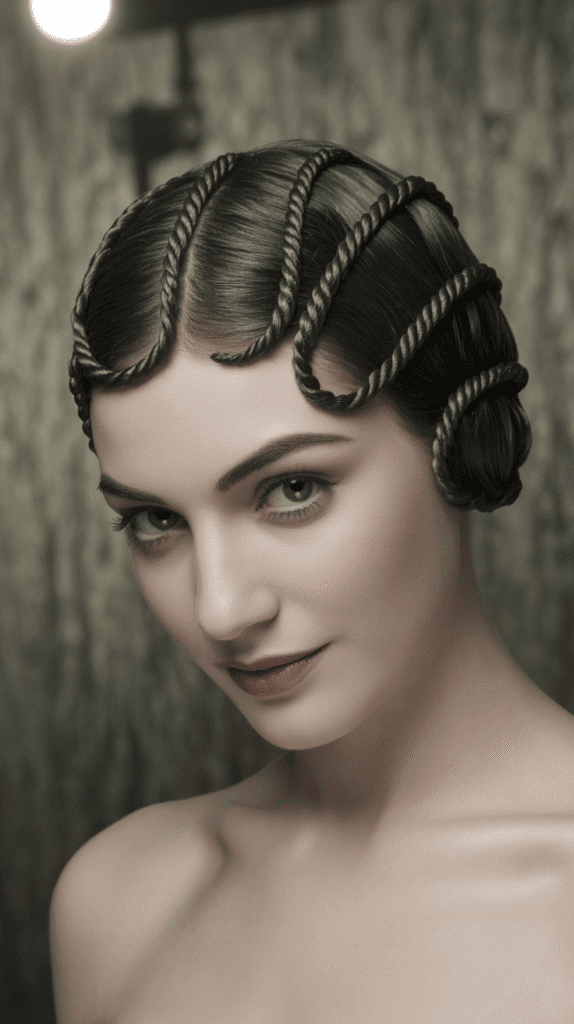
The Twisted Rope Updo incorporates rope-twisting techniques that create linear texture and architectural interest throughout the hairstyle.
This variation adds dimension through technique rather than curling, offering a different interpretation of 1930s elegance.
- Rope twists are created by dividing hair into two sections and wrapping them around each other repeatedly, creating a rope-like appearance
- Multiple rope twists can be created and arranged across the head, pinned to form geometric patterns or gathered into a central updo
- This technique works particularly well for thick, coarse hair that might not hold traditional 1930s waves as effectively
- The linear quality of rope twists provides a more modern geometric feel while still maintaining period-appropriate structure
- The style offers excellent longevity, as rope twists tend to hold their shape well throughout extended wear
- Variations include incorporating ribbon or decorative cording within the twists for added color and texture
- The updo portion can take various forms including rosettes made from twisted sections or a gathered cluster at the nape
11. Deep Wave Side Sweep
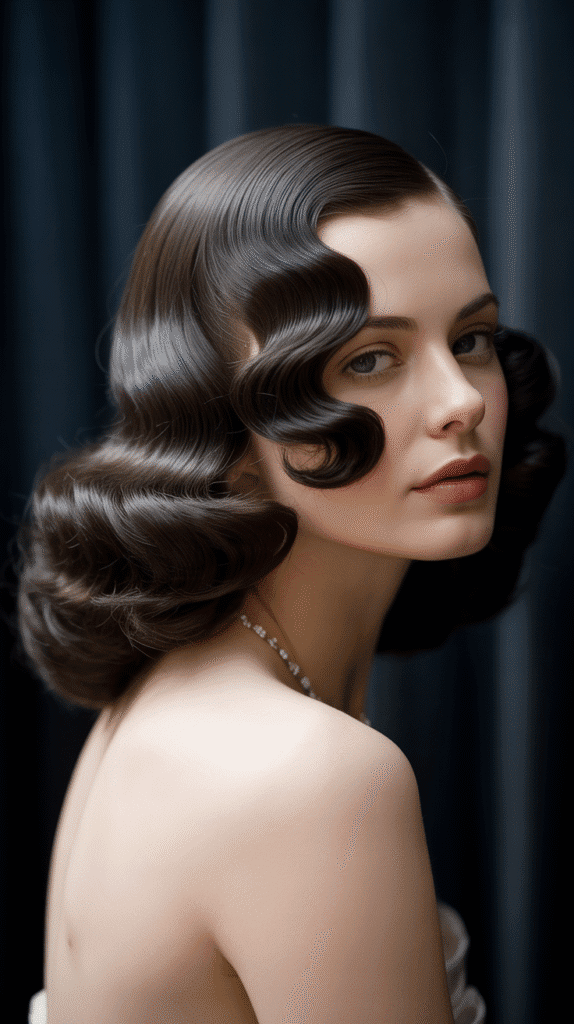
The Deep Wave Side Sweep maximizes the dramatic potential of 1930s wave styling by creating exaggerated curves that flow in a unified direction.
This bold style makes a statement while maintaining the polished refinement expected of the era.
- Waves are formed with pronounced depth, creating strong shadow and highlight patterns that photograph exceptionally well
- All hair flows toward one side of the head where it’s gathered and secured, creating a sweeping motion that emphasizes face shape
- The technique requires precise sectioning and wave formation, with each wave ridge aligned to create a cohesive directional flow
- This style particularly flatters angular face shapes by softening sharp features with the curved wave pattern
- Strong-hold setting products are essential, as the weight of all hair pulled to one side can cause waves to drop if not properly secured
- The gathered side often incorporates additional styling such as a rolled section, pinned curls, or decorative combs
- Evening events provided the perfect showcase for this dramatic style, especially under the low lighting that enhanced the wave depth
12. Figure Eight Bun
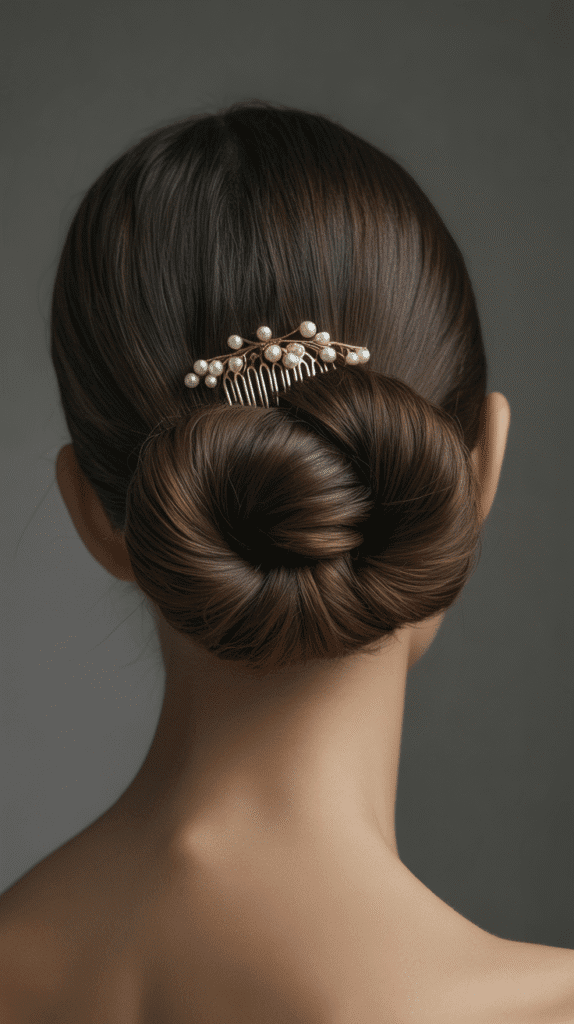
The Figure Eight Bun creates visual interest through its distinctive looped shape that resembles the number eight or infinity symbol.
This geometric approach to updo styling reflects the Art Deco influence on 1930s fashion and beauty.
- The style is created by dividing hair into sections and forming two connected loops that sit vertically or horizontally at the nape or crown
- The geometric precision required for this style made it a favorite among women who appreciated clean, modern lines in their appearance
- Hair must be long enough to create substantial loops, though padding or hair pieces could be added for those with shorter or thinner hair
- The figure eight shape creates an interesting silhouette from all angles, making it ideal for events where the back of the head would be visible
- Securing the style requires strategic pinning at the loop intersections and perimeters to maintain the distinct shape
- Variations include placing the figure eight at different locations on the head or creating multiple smaller figure eights
- The style pairs beautifully with geometric Art Deco jewelry that echoes the angular, precise aesthetic
13. Romantic Low Chignon
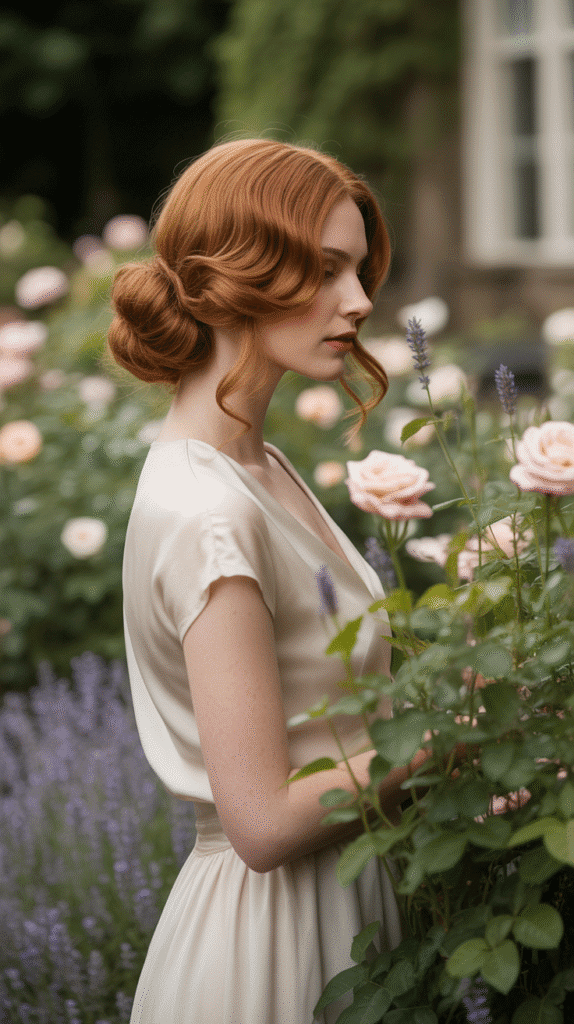
The Romantic Low Chignon softens the structured elegance of typical 1930s styling with gentler waves and a looser, more organic bun formation.
This style suited women who preferred a softer interpretation of period fashion.
- The chignon sits at the nape but incorporates softer gathering techniques rather than tight twisting, creating a more relaxed appearance
- Face-framing sections feature gentle waves rather than sharply defined finger waves, offering a more approachable elegance
- Small tendrils are often allowed to escape around the face and neck, adding to the romantic quality while still maintaining overall polish
- This style works beautifully for outdoor weddings, afternoon teas, and other events where strict formality wasn’t required
- The looser construction makes it more comfortable for all-day wear compared to tightly pinned styles
- Delicate accessories like pearl pins or small fabric flowers complement the softer aesthetic without overwhelming it
- The style bridges vintage and modern sensibilities, making it accessible for contemporary wearers exploring period styling
14. Sculptured Wave Crown
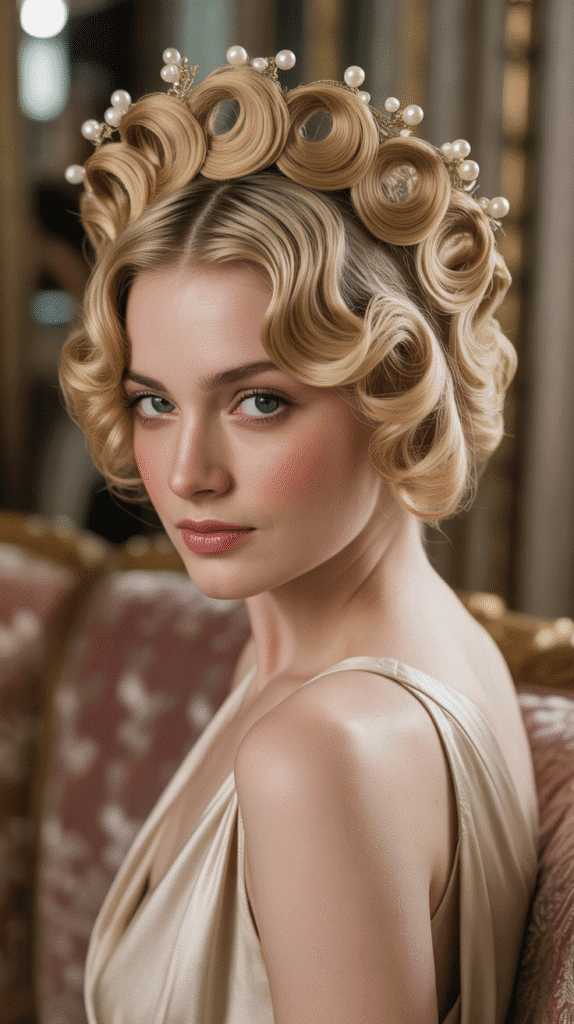
The Sculptured Wave Crown showcases wave work as an art form, with carefully arranged ridges creating a crown-like effect around the head’s upper portion.
This style demonstrates the technical mastery that defined high-quality 1930s hairstyling.
- Multiple wave patterns are created and arranged to form concentric circles or radiating designs around the crown area
- The sculptural quality requires precise sectioning and wave formation, with each wave ridge aligned to enhance the overall pattern
- Back sections are typically styled smoothly or in complementary waves that don’t compete with the crown’s focal point
- This style was reserved for the most formal occasions where elaborate hairstyling was expected and appreciated
- The technique demands considerable time and skill, often requiring professional styling for authentic execution
- Viewing from above reveals the full artistry of the wave arrangement, making it ideal for events where guests might be seated at different levels
- Modern recreations can use a combination of finger waving and pin curling to achieve the varied textures needed for sculptural effects
15. Vintage Roll and Tuck
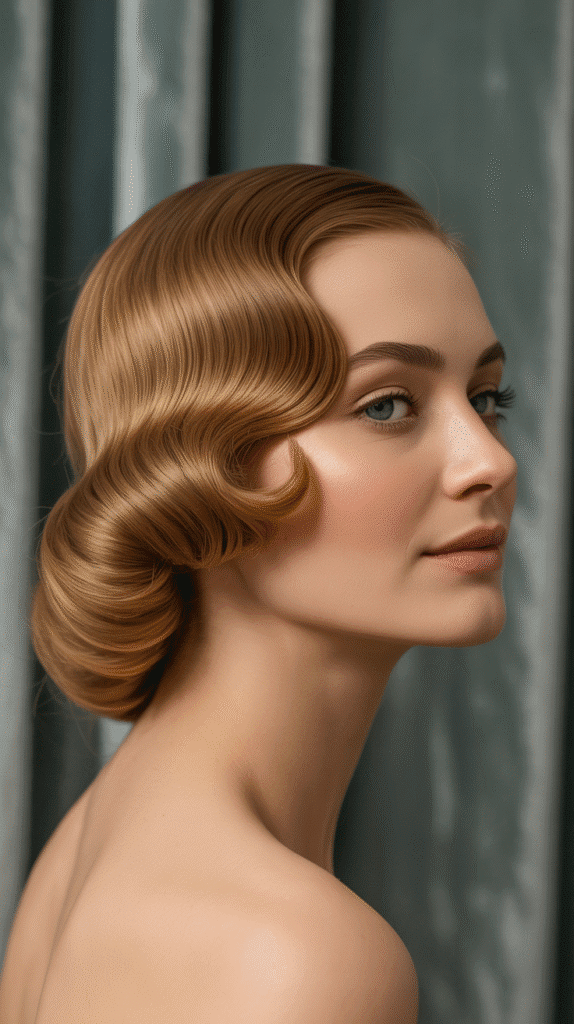
The Vintage Roll and Tuck technique creates seamless transitions between sections by rolling ends under and tucking them discretely within the hairstyle.
This method produces clean lines and a polished finish characteristic of expert 1930s styling.
- The technique involves rolling hair ends under toward the scalp and securing them invisibly, creating smooth surfaces without visible ends
- Multiple rolled and tucked sections can be arranged to build volume and shape without relying on ratting or teasing
- This method works particularly well for creating the smooth, rounded shapes favored in 1930s updos
- The style requires hair of sufficient length to roll under substantially, though shorter hair can still achieve smaller-scale versions
- Proper technique ensures comfortable wear, as ends tucked correctly don’t create pressure points against the scalp
- The rolling motion naturally creates gentle curves that enhance the overall flow of the hairstyle
- This foundational technique appears in many 1930s styles, making it essential knowledge for authentic period recreation
16. Asymmetrical Wave Arrangement
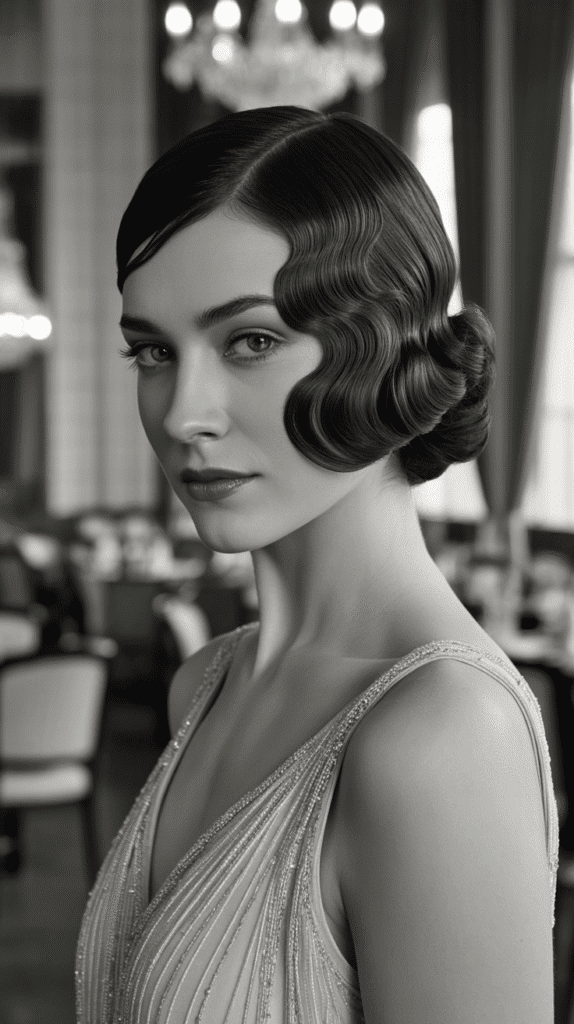
The Asymmetrical Wave Arrangement intentionally creates imbalance through varied wave placement and direction, resulting in a modern, fashion-forward interpretation of 1930s styling.
This approach reflected the era’s growing confidence in breaking traditional beauty rules.
- Waves on one side of the head might be deeper or more numerous than the opposite side, creating deliberate asymmetry
- The directional flow of waves changes across different sections, adding visual complexity and movement
- This style suited confident women who wanted to stand out from more conservative styling choices
- The technique requires careful planning to ensure asymmetry appears intentional rather than accidental or poorly executed
- Face shape considerations become crucial, as asymmetry can either enhance or detract from natural features depending on placement
- The style photographs beautifully from multiple angles, as each view presents a different wave pattern and arrangement
- Modern fashion has embraced similar asymmetrical approaches, making these vintage styles feel surprisingly contemporary
17. Pearl-Adorned Chignon
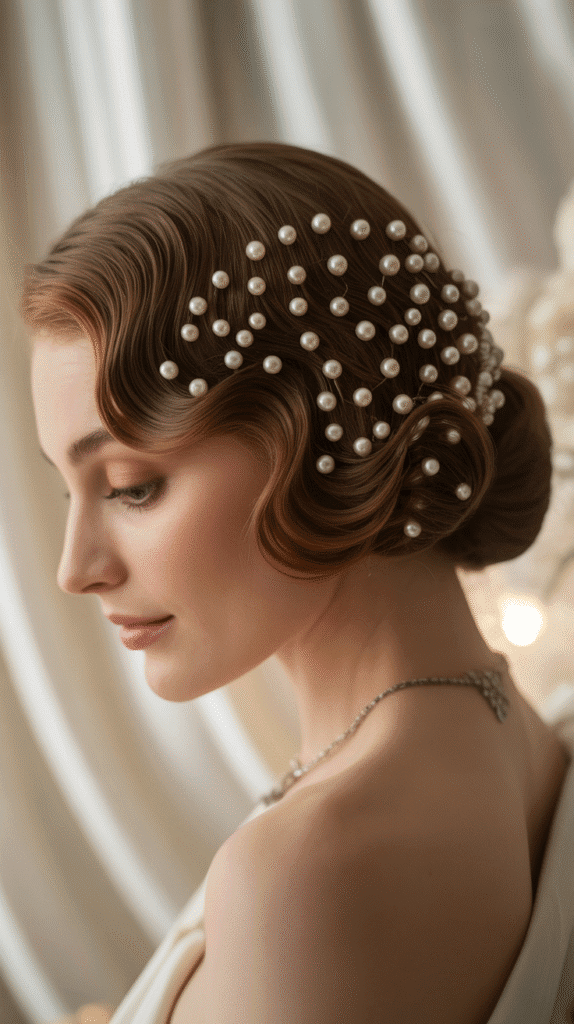
The Pearl-Adorned Chignon elevates the simple elegance of a basic chignon through strategic placement of pearls, which were the quintessential jewelry of the 1930s.
This style combines understated base styling with luxurious embellishment.
- The chignon forms a smooth, classic base typically positioned at the nape or lower crown area
- Pearl pins, combs, or strands are arranged throughout or around the chignon, adding luminous accents
- The combination of matte hair texture and lustrous pearls creates appealing visual contrast
- This style was particularly popular for brides and formal evening events where elegance and sophistication were paramount
- The pearls can be arranged in linear patterns, clustered groups, or scattered individually depending on desired effect
- Hair color considerations matter, as pearls provide different contrast levels against various hair shades
- The style works with both real pearls for authentic period accuracy or high-quality imitation pearls for budget-friendly recreation
18. Horizontal Roll Style
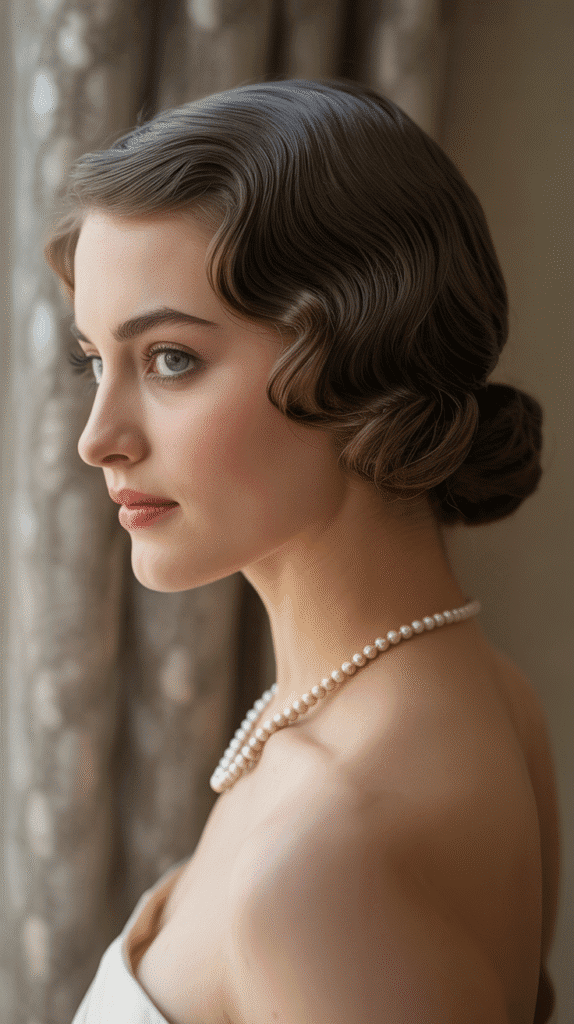
The Horizontal Roll Style creates parallel rolled sections that lie horizontally across the back of the head, producing a distinctive linear pattern.
This geometric approach reflects the influence of industrial design aesthetics on 1930s fashion.
- Hair is sectioned horizontally and each section is rolled toward the scalp, creating stacked cylindrical shapes
- The rolls are typically uniform in size, emphasizing the geometric precision of the style
- This technique works best on medium to long hair with enough length to create substantial rolls
- The style can be created with hot rollers for more permanent set or with pin curling techniques for softer results
- Strategic placement of rolls creates different silhouettes, with higher placement adding height and lower placement emphasizing neck length
- The linear quality makes this style particularly photogenic from profile and back views
- Variations include alternating roll directions or sizes to create more complex patterns
19. Finger Wave Bob Updo
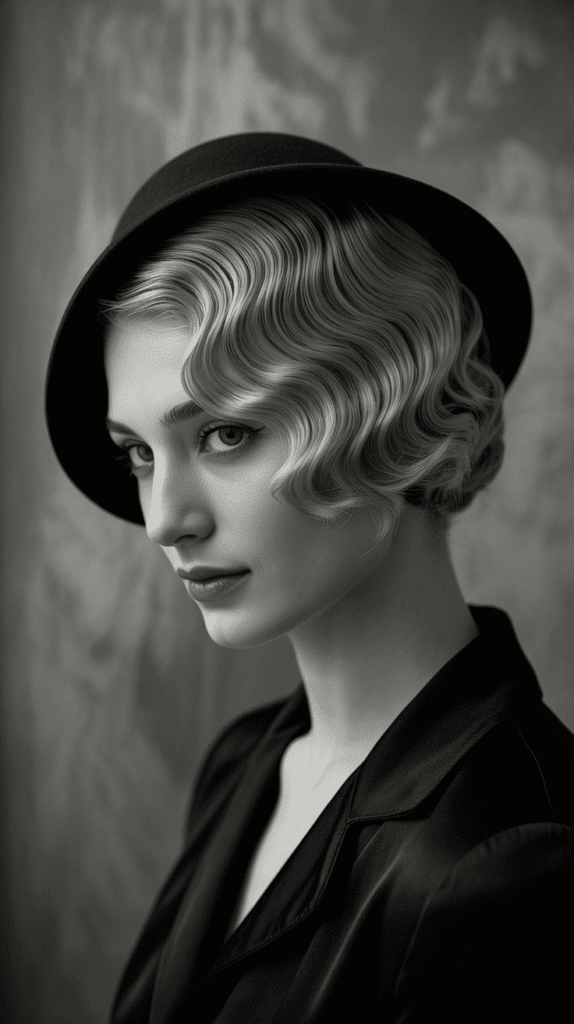
The Finger Wave Bob Updo works with shorter hair lengths to create an updo effect through strategic pinning and wave formation.
This style proves that elaborate 1930s updos weren’t limited to long-haired women.
- The bob-length hair is finger waved throughout, creating texture and volume that appears more substantial than the actual length
- Back sections are pinned up and under to create the illusion of an updo while maintaining the waves’ integrity
- This style requires expert pinning to ensure security while keeping bobby pins invisible
- The technique made elaborate styling accessible to the many women who wore bob haircuts throughout the decade
- Face-framing waves receive particular attention, as they create the style’s primary visual impact
- The pinned-up sections can be arranged in various configurations including faux buns, tucked rolls, or clustered curls
- This approach bridges the gap between short and long styling, offering versatility for various hair lengths
20. Wrapped Chignon Base
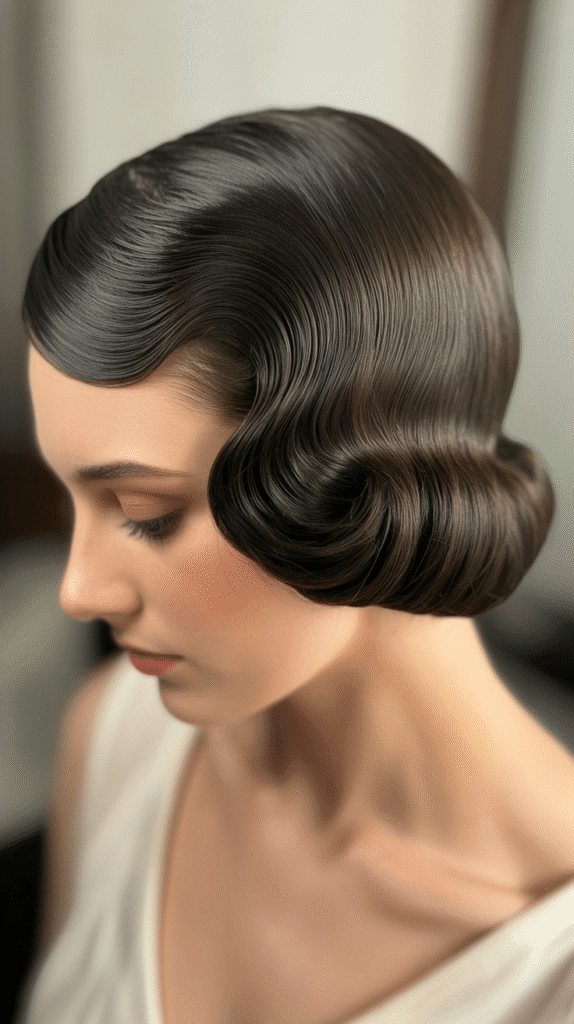
The Wrapped Chignon Base uses a core structure around which hair is wrapped to create volume and perfect roundness.
This technique was often kept secret by professional hairdressers who prided themselves on creating flawless chignon shapes.
- A padding base, historically made from wire mesh or felt, is positioned at the desired chignon location
- Hair is wrapped around this base in smooth, overlapping layers that conceal the padding completely
- The technique guarantees a perfectly shaped chignon regardless of natural hair thickness or texture
- Securing requires pins inserted through the wrapped hair into the padding base for maximum stability
- The method became popular as it allowed even women with fine or thin hair to achieve substantial updos
- Modern recreations often use foam bun forms or sock buns to achieve similar volume and shape
- The wrapped technique creates exceptional smoothness as hair is laid rather than gathered, eliminating lumps
21. Tiered Wave Formation
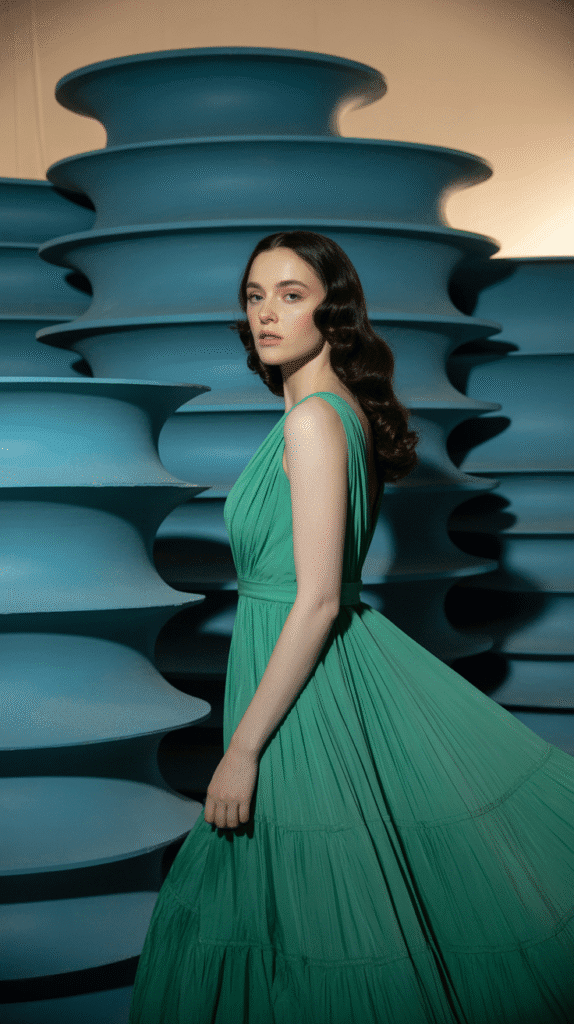
The Tiered Wave Formation creates layers of waves stacked at different heights, producing dimensional depth that enhances the style’s visual complexity.
This advanced technique showcased a hairstylist’s technical expertise.
- Waves are formed at varying heights from the scalp, with some sitting closer to the head and others elevated slightly above
- The tiering effect creates shadow patterns that add dramatic dimension to the overall style
- This technique requires expert sectioning and wave formation to ensure even distribution and balanced appearance
- The style works particularly well for evening events with dramatic lighting that emphasizes the dimensional quality
- Securing the elevated waves requires strategic pinning at the ridges to maintain separation between tiers
- The back sections can be styled into complementary waves or gathered into an updo that allows the tiered front to star
- Modern stylists can achieve similar effects using a combination of finger waving and strategic teasing techniques
22. Grecian-Inspired Updo
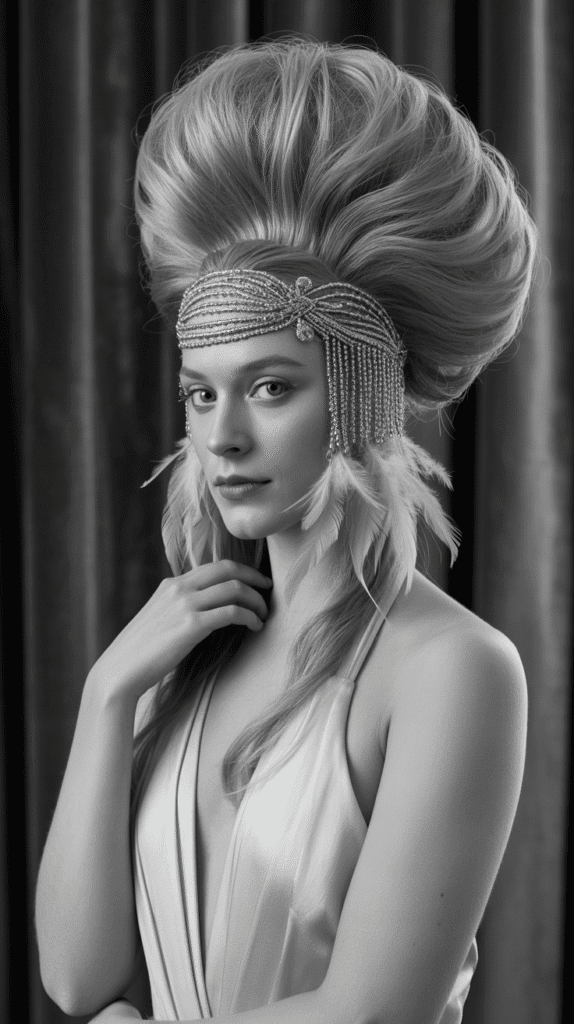
The Grecian-Inspired Updo blends classical antiquity references with 1930s sensibilities, creating a style that feels both timeless and contemporary to the era.
This fusion reflected the period’s fascination with neoclassical aesthetics.
- Hair is arranged in loose, flowing sections that reference ancient Greek hairstyles while maintaining 1930s wave techniques
- Fabric bands, ribbons, or metallic cords are often incorporated as headbands or decorative elements, echoing Grecian accessories
- The updo typically features height at the crown with flowing elements that create vertical lines and elegant draping
- This style suited both classical-themed events and general formal occasions where dramatic elegance was desired
- The flowing quality creates movement and softness that contrasts with more structured 1930s styles
- Strategic pinning maintains the flowing appearance while ensuring security throughout wear
- The style’s theatrical quality made it popular for performers and those attending elaborate costume events
23. Swept Back Wave Style
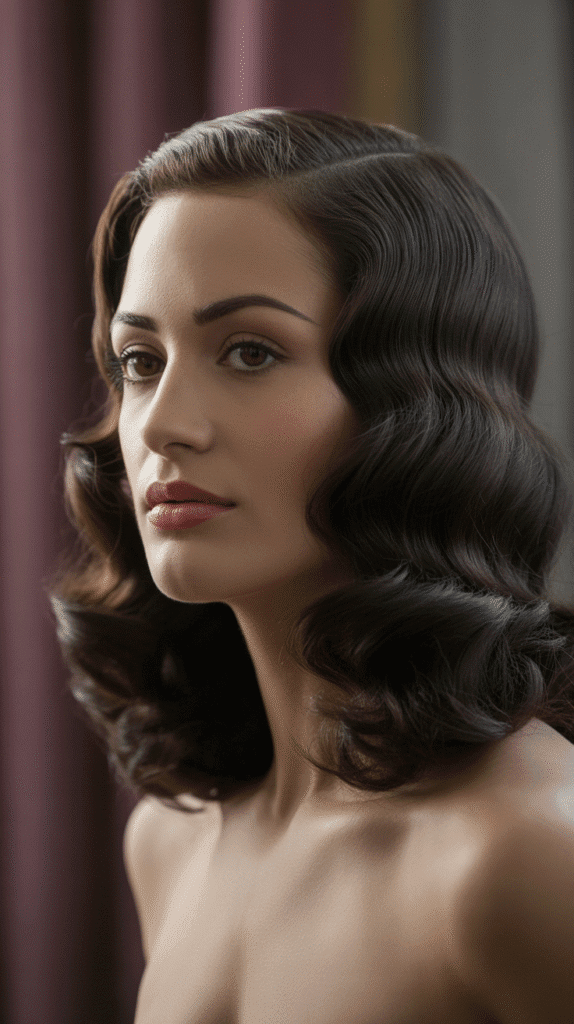
The Swept Back Wave Style pulls all hair away from the face in continuous waves that flow toward the back, creating an open, sophisticated appearance.
This style particularly suited women with strong facial features they wanted to showcase.
- All face-framing sections are waved and directed backward, leaving the forehead and face completely exposed
- The sweeping motion creates elongating vertical lines that complement various face shapes
- Back sections continue the wave pattern or transition into an updo, maintaining visual flow throughout
- This style requires confident wearing, as the exposed face receives full focus without softening tendrils
- The technique works best with well-defined facial features and good bone structure that benefit from exposure
- Strong-hold products are essential to maintain the backward direction and prevent sections from falling forward
- The style pairs beautifully with statement makeup and bold accessories that compete for attention with the dramatic hair
24. Faux Bob Updo
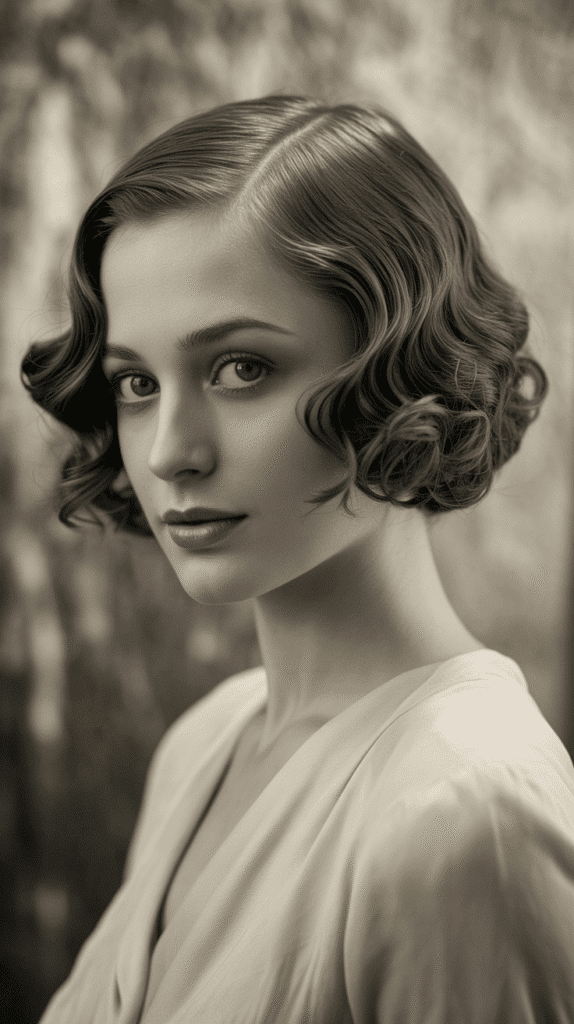
The Faux Bob Updo creates the appearance of a short bob haircut while actually pinning long hair up and under.
This clever technique allowed women to experiment with shorter styles without committing to cutting their hair.
- Long hair is waved or curled, then folded and pinned at approximately jaw or chin length to mimic a bob
- The pinned sections are concealed beneath the “bob” length hair, creating a seamless illusion
- This style offered versatility, allowing women to wear their hair long or short-appearing depending on the occasion
- Creating a convincing faux bob requires careful pinning to ensure no long sections are visible from any angle
- The technique works best with substantial volume, as flat hair reveals the pinned structure more easily
- Face-framing waves or curls enhance the illusion by creating movement typical of actual bob haircuts
- The style gained particular popularity as bob haircuts became fashionable, allowing conservative women to follow trends without permanent changes
25. Ornate Side Bun
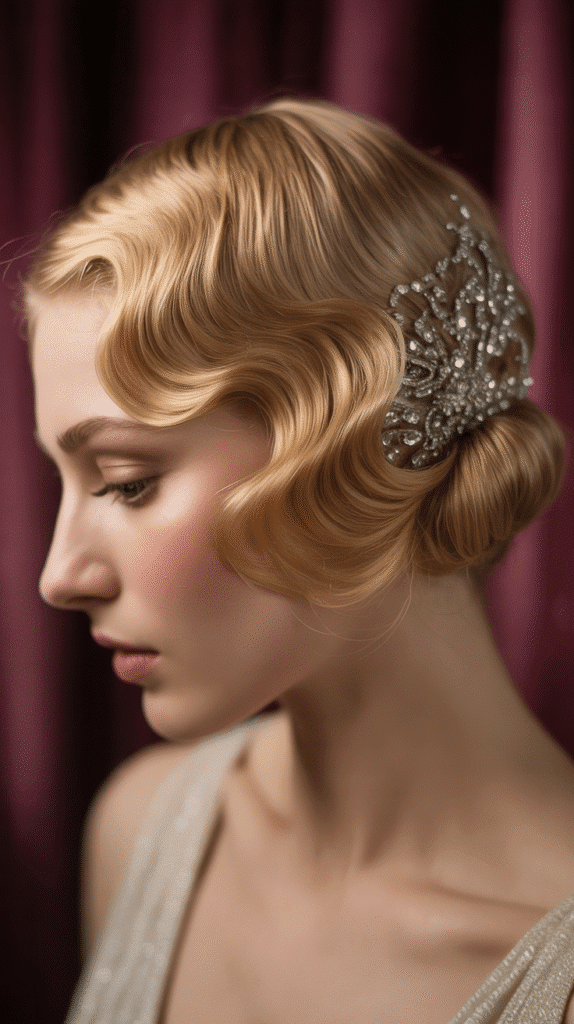
The Ornate Side Bun positions the updo’s focal point at the side of the head rather than center back, creating asymmetry and visual interest.
This placement allowed for elaborate embellishment that could be easily seen.
- The bun sits behind and slightly below the ear on one side, creating a balanced asymmetrical look
- Elaborate decorations including combs, flowers, feathers, or jeweled pins are easily incorporated into the side placement
- Opposite side hair is styled with waves or smooth sections that sweep toward the bun, creating directional flow
- This style works particularly well for profile photography, as both the face and ornate bun are visible simultaneously
- The side placement makes the bun accessible for adjustment throughout an event, offering practical benefits
- Securing requires substantial pinning as the off-center weight can cause shifting if not properly anchored
- The style reflects the 1930s preference for asymmetry and personal expression in formal styling
26. Criss-Cross Pin Pattern

The Criss-Cross Pin Pattern uses visible bobby pins arranged in decorative patterns as a design element rather than hiding them.
This innovative approach transformed functional tools into artistic embellishments.
- Bobby pins are arranged in X patterns, geometric designs, or parallel lines across wave ridges or smooth sections
- The pins are often selected in contrasting colors to the hair or in metallic finishes for added visual impact
- This technique reflects the era’s growing acceptance of showing construction elements as part of the overall design
- The criss-cross pattern provides both security and decoration, serving dual purposes efficiently
- Strategic placement can emphasize wave patterns, create focal points, or add geometric interest to smooth sections
- This style particularly suited younger, more fashion-forward women who embraced modern design aesthetics
- Modern recreations can use decorative bobby pins in various finishes including gold, silver, and jeweled options
27. Double Chignon Style
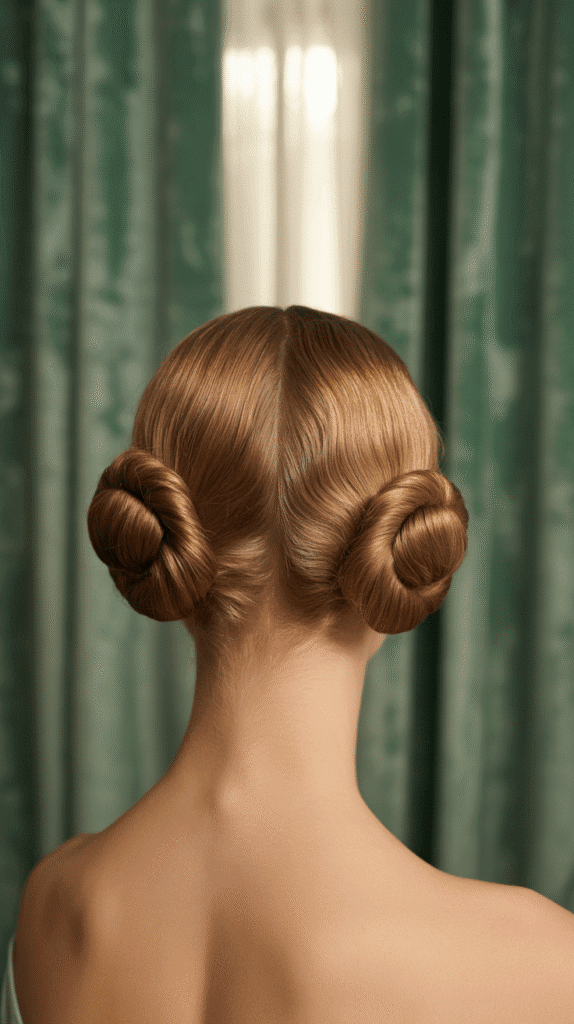
The Double Chignon Style creates two separate bun structures positioned at different locations on the head, producing visual interest through repetition and balance.
This architectural approach demonstrates advanced styling skills.
- Two chignons are typically positioned vertically, with one at the crown and another at the nape, or horizontally at each side
- Each chignon can be identical in size and construction or varied for different effects
- The dual structure creates interesting silhouettes from all viewing angles, making it ideal for events with guests at varying heights
- Hair is sectioned strategically to allocate appropriate amounts for each chignon while maintaining balance
- Connecting waves or smooth sections between chignons create visual flow and unity
- The style requires meticulous execution to ensure both chignons appear intentional rather than haphazard
- Variations include different chignon constructions for each bun, mixing wrapped and twisted techniques for textural contrast
28. Waterfall Wave Cascade
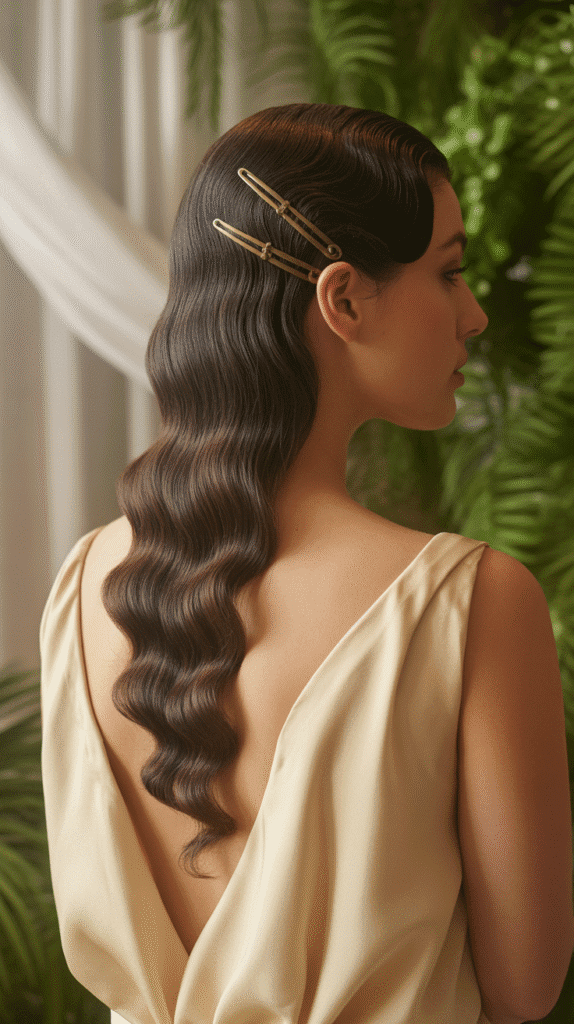
The Waterfall Wave Cascade creates the illusion of waves flowing downward like falling water, with the updo portion gathering this “cascade” at a lower point.
This poetic interpretation of wave styling emphasized fluid motion.
- Waves are arranged to create a downward directional flow that mimics water movement
- The cascade effect is achieved through careful wave placement and graduated sizing that creates momentum
- The gathering point, typically at the nape or side, appears to collect the “flowing” waves like a pool
- This style works beautifully for romantic events and suits women who wanted softer, more organic styling
- The fluid quality requires waves to blend seamlessly rather than appearing as separate, distinct elements
- Lighting plays a crucial role in emphasizing the cascade effect, with highlighting enhancing the downward flow
- The technique balances structure with movement, maintaining 1930s polish while incorporating dynamic elements
29. Coronet Braid Updo
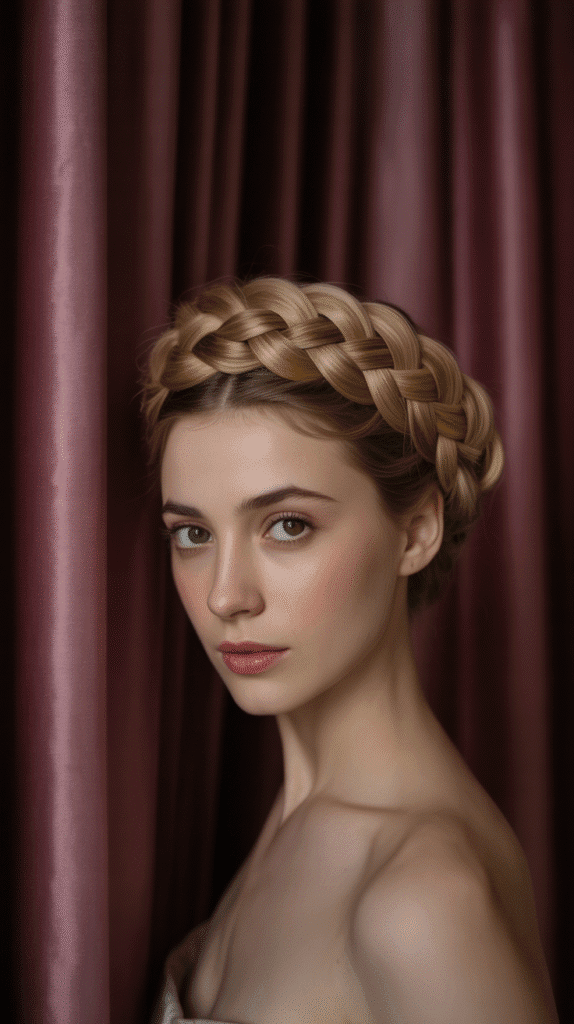
The Coronet Braid Updo crowns the head with a braid that encircles like a halo, creating a regal appearance perfect for formal occasions.
This style combines the structure of braiding with the elegance expected in 1930s formal styling.
- A thick braid is formed from all or most of the hair and arranged to circle the head like a crown
- The braid typically starts at one side of the nape, travels around the head, and ends tucked beneath itself on the opposite side
- This style works exceptionally well for thick hair that creates substantial braids, though padding can be added for thinner hair
- The coronet placement creates a majestic appearance suitable for brides, debutantes, and formal evening events
- Decorative elements like small flowers, pearls, or ribbon can be woven through or pinned to the braid
- The style keeps hair completely off the face and neck, making it practical for warm weather formal events
- Securing requires pins placed both within the braid structure and anchoring it to the head
30. Nested Pin Curl Cluster
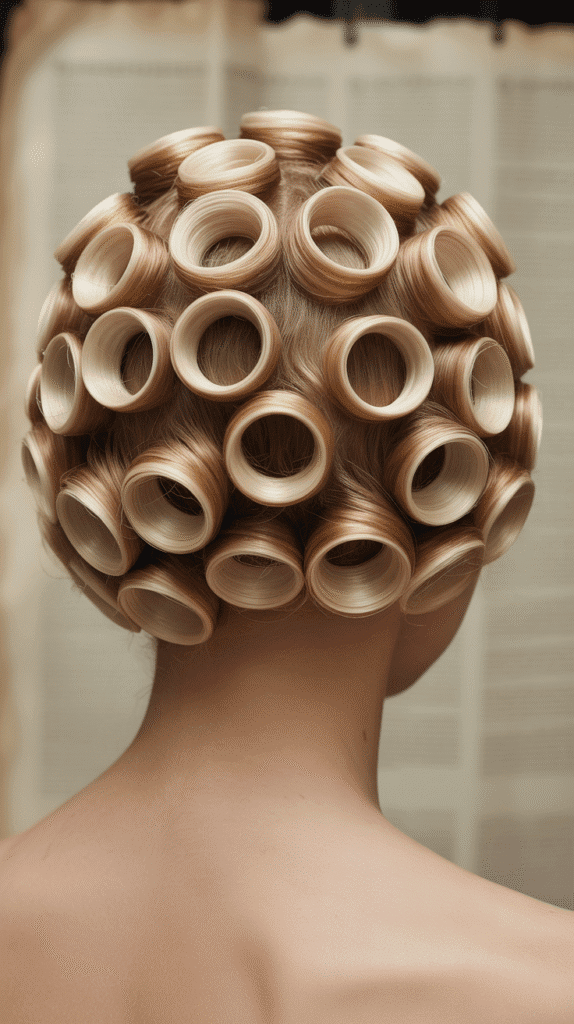
The Nested Pin Curl Cluster arranges pin curls in concentric patterns where curls nestle within each other, creating rosette-like formations.
This intricate technique demonstrates the artistic potential of basic pin curling methods.
- Pin curls are arranged in circular patterns with each ring of curls surrounding a central curl, building outward
- The nested arrangement creates depth and dimension that flat pin curl patterns cannot achieve
- Multiple clusters can be positioned strategically across the head, with smooth sections connecting them
- This style requires precise curl formation to ensure uniform size and consistent direction for proper nesting
- The rosette effect becomes most apparent after curls are set, unwound, and gently separated without brushing
- Clusters work beautifully as focal points, drawing the eye to desired areas while balancing overall composition
- The technique allows for creative expression while maintaining the controlled elegance characteristic of 1930s styling
- Modern recreations benefit from using setting lotion and allowing full drying time to preserve the nested structure
31. Sleek Top with Textured Nape
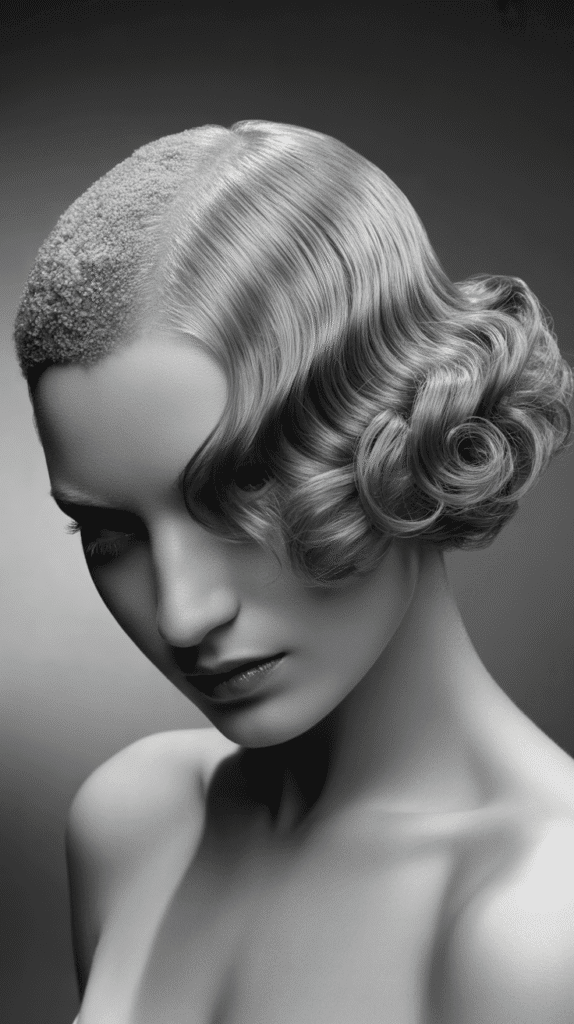
The Sleek Top with Textured Nape creates contrast between mirror-smooth crown sections and elaborately textured nape styling.
This juxtaposition showcases different styling techniques within one cohesive hairstyle.
- The top and crown sections are brushed completely smooth using pomade or gel, creating a glossy, sculpted appearance
- The nape area features intricate curls, waves, or twisted elements that provide textural richness
- This contrast approach adds visual interest while maintaining overall sophistication and polish
- The style works particularly well for women with naturally thick hair that can support both sleek and textured sections
- The smooth top creates a canvas that emphasizes facial features without distraction
- The textured nape adds femininity and softness that balances the severity of the slicked sections
- Strategic pinning keeps the textured elements secure while maintaining their dimensional quality
- The style photographs beautifully from multiple angles, as each view reveals different aspects of the contrast
32. Spiral Roll Formation
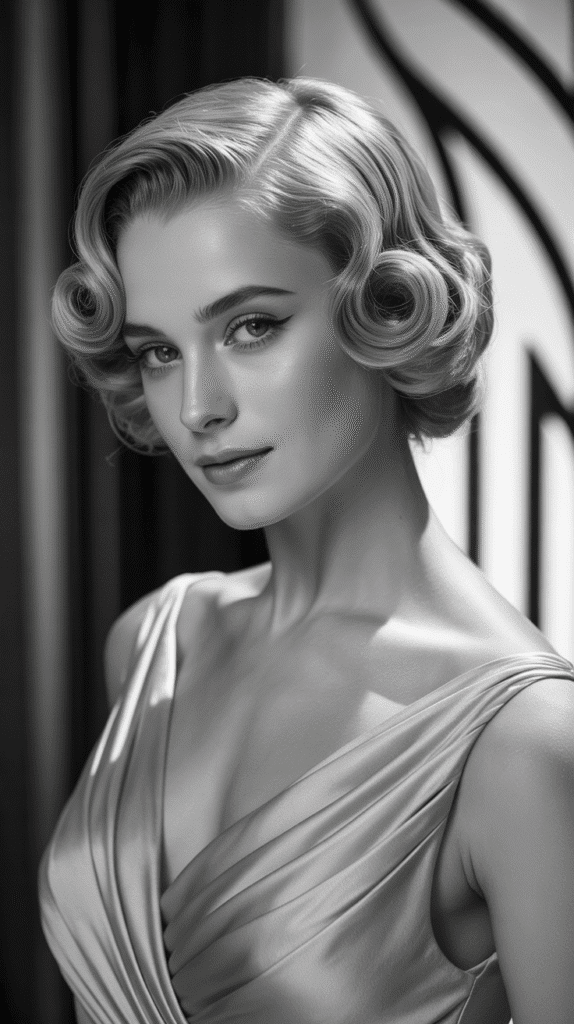
The Spiral Roll Formation creates cylindrical rolled sections that curve in spiral patterns rather than straight lines.
This dynamic approach adds movement and energy to structured updo styling.
- Hair sections are rolled while simultaneously twisted, creating spiral rather than flat rolls
- The spirals can be arranged vertically, horizontally, or in curved patterns across the head
- This technique adds dimensional interest as spirals catch light differently than flat surfaces
- The style works best with longer hair that can sustain multiple rotations within the spiral
- Securing requires pins inserted through the spiral at multiple points to prevent unraveling
- The dynamic quality suits women who wanted less static styling while maintaining period-appropriate elegance
- Variations include mixing different spiral sizes or combining spirals with other techniques for complex compositions
- The style reflects growing experimentation within 1930s hairstyling as the decade progressed
33. Art Deco Geometric Updo
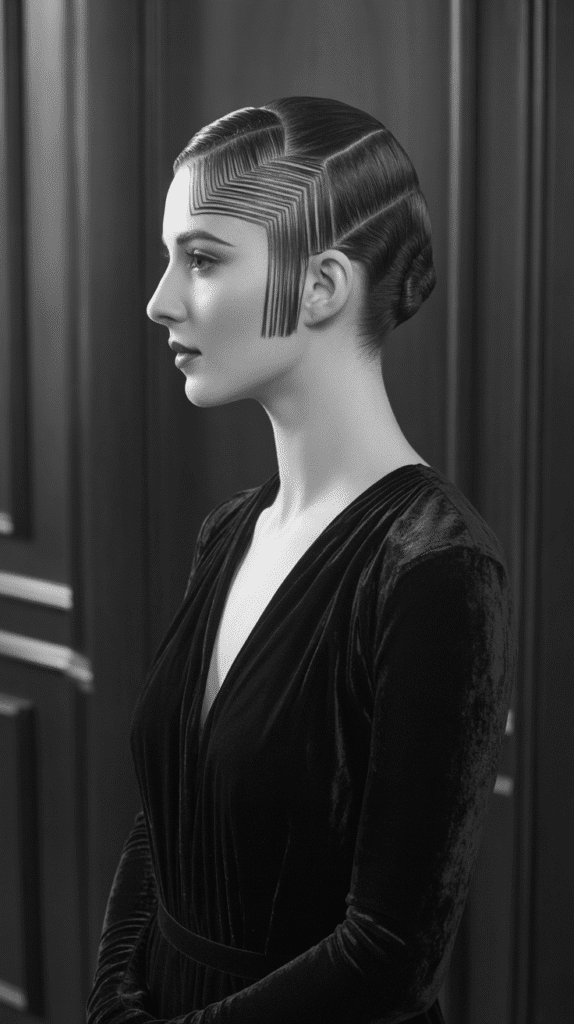
The Art Deco Geometric Updo fully embraces the angular, linear aesthetic of Art Deco design, translating architectural principles into hairstyling.
This avant-garde approach represented the pinnacle of fashion-forward 1930s styling.
- Hair is arranged in sharp angles, straight lines, and geometric shapes that echo Art Deco architecture and design
- Techniques include severely straight sections, angular parts, and precisely positioned elements that create geometric patterns
- This style was reserved for the most fashion-conscious women attending cutting-edge social events
- The geometric precision requires expert sectioning and meticulous execution to achieve clean lines
- Strong-hold products are essential to maintain the angular shapes and prevent softening throughout wear
- The style pairs perfectly with Art Deco fashion featuring geometric beading, angular silhouettes, and bold accessories
- Metallic accessories, geometric clips, and architectural combs enhance the overall aesthetic
- This represents the most modern interpretation of 1930s styling, pushing boundaries while remaining rooted in period techniques
- The style photographs exceptionally well in black and white, where contrast emphasizes the geometric elements
- Always work with completely clean hair, as 1930s styles require hair that can hold shape and styling products effectively
- Section hair methodically before beginning any style, as proper sectioning determines the success of wave patterns and updo structures
- Use setting lotion on damp hair for pin curls and finger waves, allowing full drying time before manipulating the set
- Invest in quality bobby pins in various sizes, as securing these elaborate updos requires substantial pinning
- Practice finger wave formation on mannequin heads before attempting on your own hair, as the technique requires muscle memory
- Consider your face shape when selecting which vintage style to recreate, as 1930s hairstylists were expert at using hair to enhance features
- Keep strong-hold hairspray available for finishing touches and securing any sections that might shift during wear
- For authentic texture, avoid over-brushing set curls; instead, gently separate with fingers to maintain definition
- Allow extra time for elaborate styles, as rushing produces sloppy results that lack the precision characteristic of the era
- Photograph your styling process to learn from each attempt and track improvement in technique execution
Conclusion
The timeless elegance captured in these 33 Vintage 1930s Updo Hairstyles for Special Occasions continues to inspire contemporary styling precisely because these looks embody sophistication, craftsmanship, and artistic vision that transcends decades.
Each hairstyle represents not merely a fashion choice but a commitment to beauty as an art form, where every wave ridge, pin placement, and rolled section served a deliberate purpose in creating harmonious elegance.
Whether you’re drawn to the architectural precision of geometric updos, the romantic softness of loose chignons, or the dramatic impact of deep finger waves, these vintage styles offer endless possibilities for modern special occasions.
The techniques developed during the 1930s laid the foundation for professional hairstyling as we know it today, introducing methods and approaches that remain relevant in contemporary salons and on fashion runways worldwide.
By recreating these classic looks, you’re not simply wearing a hairstyle—you’re embodying an era when beauty routines required patience, skill, and artistry, and when the journey to achieving the perfect updo was valued as much as the stunning result.
As you experiment with these styles for your next wedding, gala, vintage-themed event, or special celebration, remember that the true spirit of 1930s beauty lies not in perfect replication but in adapting these timeless techniques to showcase your individual beauty with confidence, grace, and that unmistakable touch of Old Hollywood glamour.
